From Waves to Dictionary: a beginner's guide to surfing slang
Authors: Einārs & Ieva Landmaņi / July 19, 2025 / Reading time 7 Minutes
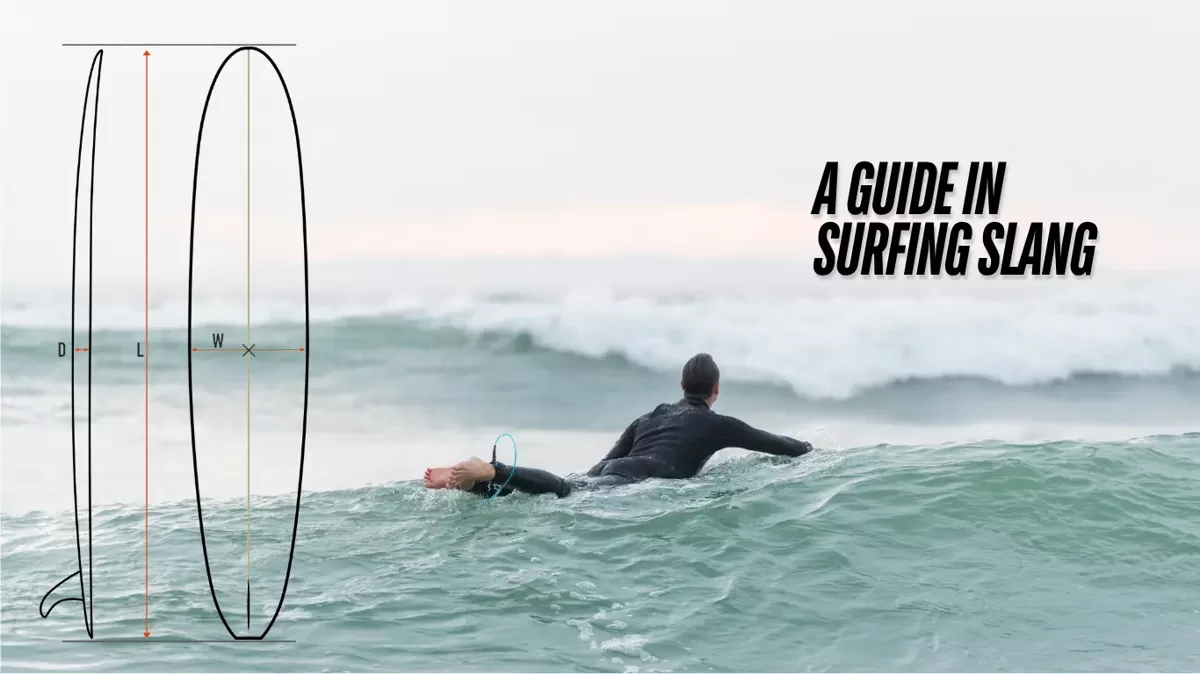
So from where does a surfboard actually begin?
Surfboard dimensions — how do you define them?
- L – the board’s total length (measured in feet and inches)
- W – the width at the center (in inches)
- D – the thickness (in inches, measured at the midpoint of the board — point X in the above diagram)
- X – the center of the board
Mastering the surf paddle — find your “sweet spot”
To paddle means to propel the board forward while lying flat and alternating arm strokes. To find the “sweet spot” for paddling on a specific board length, try to position yourself so that:
✅ the nose of the board is lifted about 3–5 cm above the water,
✅ your back is slightly arched,
✅ chin is raised,
✅ legs together,
✅ and you paddle in strong, controlled strokes using both arms.
Does wider board immediately mean more stability?
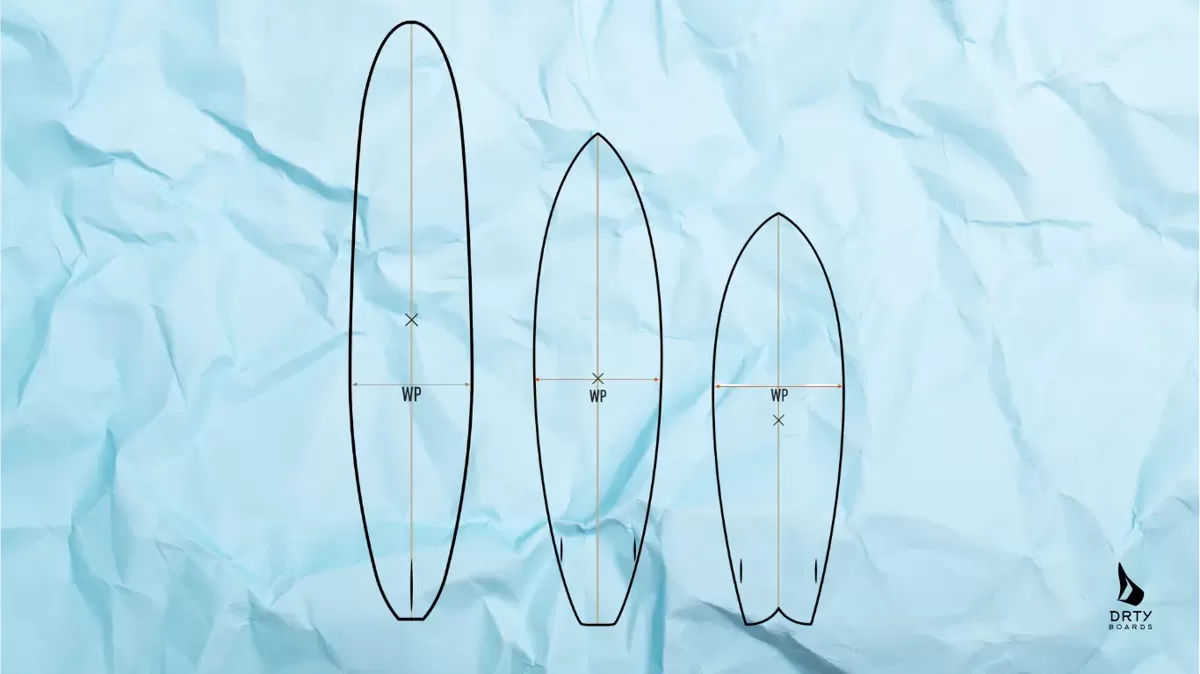
To take your surfing to the next level, it’s important to understand the position of the board’s widest point — the “wide point” (WP) — in relation to the centre of the board (X), as it directly affects the board’s performance.
There are three main WP placements:
1️⃣ Wide Point behind the centre (toward the tail):
- This extends the outline of the tail, helping the board turn and manoeuvre more easily.
- It narrows the nose outline proportionally, reducing foam volume and weight in the front — making the board more responsive.
- A rear-positioned WP is ideal for surfers who ride more with their back foot.
2️⃣ Wide Point at the centre of the board:
- Placing the WP at the midpoint gives the board a more balanced outline.
- The nose and tail are more similar in width, and a wider nose increases overall stability.
- This layout offers the best balance between manoeuvrability and stability.
- As a general rule: the wider the board, the more stable it is in the water!
3️⃣ Wide Point in front of the centre (toward the nose):
- This design increases lift and stability at the front of the board.
- A forward WP is typical for longboards, helping in smaller, mushy waves and making it easier to engage the rail early.
- The tail becomes narrower, improving turning and manoeuvrability.
- A front-positioned WP suits surfers who rely more on their front foot while riding.
Volume UP! The key to buoyancy and paddle power
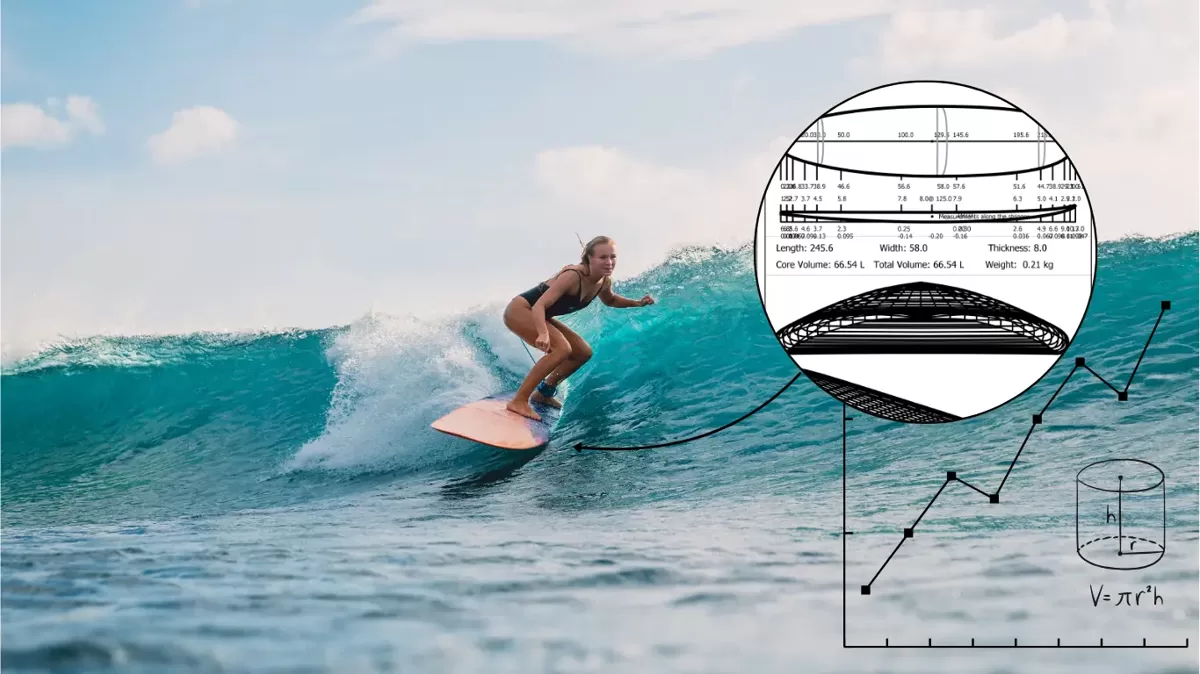
Volume determines how buoyant a surfboard will be — the higher the volume, the less water resistance while paddling and the easier it is to catch flatter, slower waves. For regular-shaped objects, volume is calculated using the formula: length × width × depth = volume. But since a surfboard is a complex 3D object, its precise volume is calculated using specialized surfboard software and expressed in litres.
Volume is most directly affected by the overall thickness of the board — even a tiny 3 mm increase can add several liters of volume, which won’t be visually noticeable.
The greater the volume, the easier the paddle, and the more beginner-friendly the ride — especially in mellow waves.
However, volume alone is not the most important factor when choosing your next board. You also need to consider the full set of standard dimensions (LWD), along with the outline and the rocker.
Rocker: the curve that shapes your ride
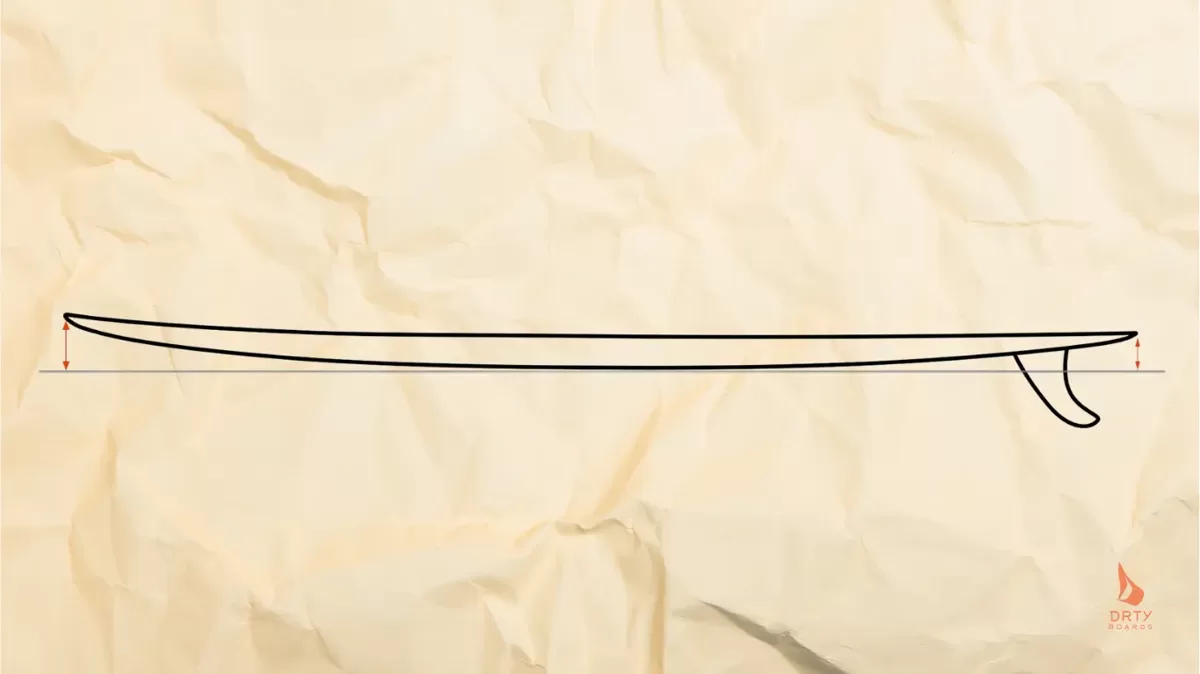
The rocker is the continuous curve from the tail to the nose when viewed from the side. It determines how the board moves through water — while paddling, catching waves, and riding them.
There are two main types of rocker:
✅ Nose rocker – the curve in the front part of the board
✅ Tail rocker – the curve in the rear part of the board
If the nose rocker is too steep, it can act like a “water plow,” pushing a lot of water and slowing the board down.
A pronounced tail rocker increases downforce on the back of the board, which can slow the board in bigger waves at high speeds.
The steeper and larger the wave, the more nose rocker you’ll need.
In small to medium waves, a moderate nose and tail rocker helps catch waves more easily.
If you’re a beginner riding whitewater, a board with more rocker can actually help you.
The Stringer – a surfboard’s backbone
The stringer is a thin piece of wood or plywood running down the centre of the foam blank. It provides longitudinal strength and prevents breakage. Essentially, it’s the board’s spine.
As you surf dynamically, the stringer flexes and compresses. When you finish a turn, it snaps back into shape, giving you a burst of speed. This is known as flex, and it enhances your ability to accelerate during manoeuvres.
Outline – the surfboard’s overall shape

The outline is the shape of the board when viewed from the top or bottom:
- Longer boards tend to have fuller, rounder outlines, which improve stability and paddle ease.
- Shorter boards feature sharper noses and tails, offering better manoeuvrability and more dynamic surfing.
For beginners in small, mellow waves, a fuller outline is recommended. More advanced surfers might prefer a sharper outline for more drive and responsiveness.
The Nose – rounded or pointed?
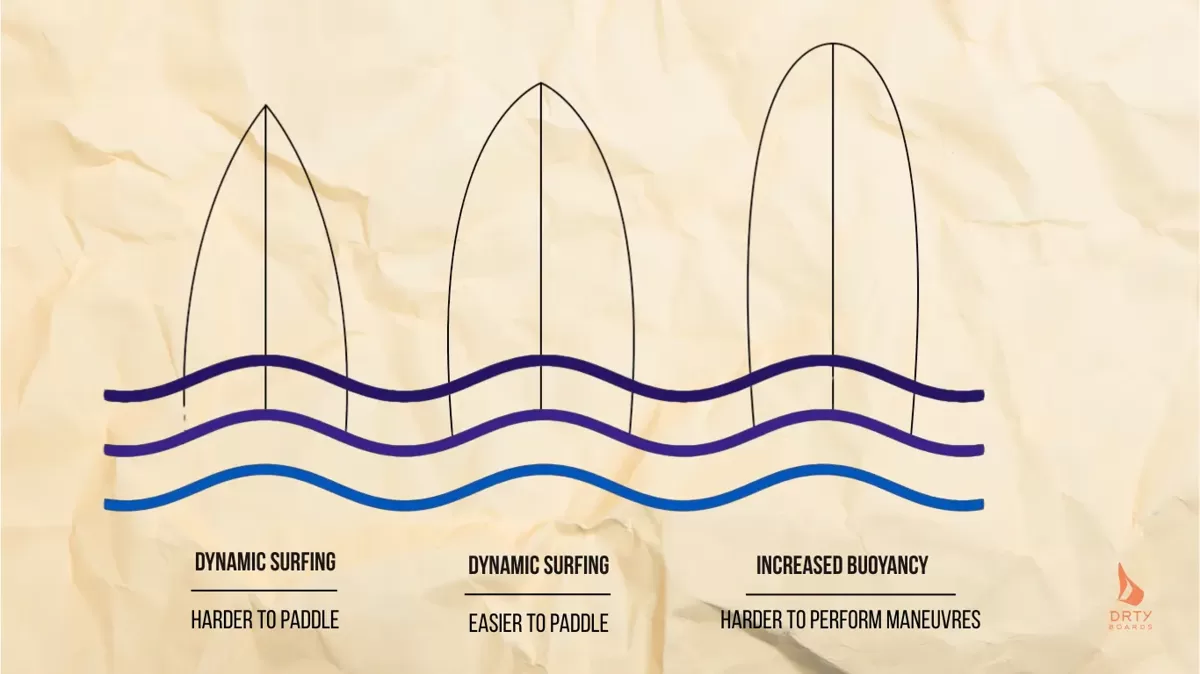
The shape of the nose is one of the key factors that affects paddling and wave-catching ability:
- a wider, rounder nose means more surface area, offering better buoyancy and stability.
- a narrow, pointed nose reduces front-end weight, increasing agility and control in steep and fast waves — especially when barrel riding.
Tail Shapes – how they influence your surfing?
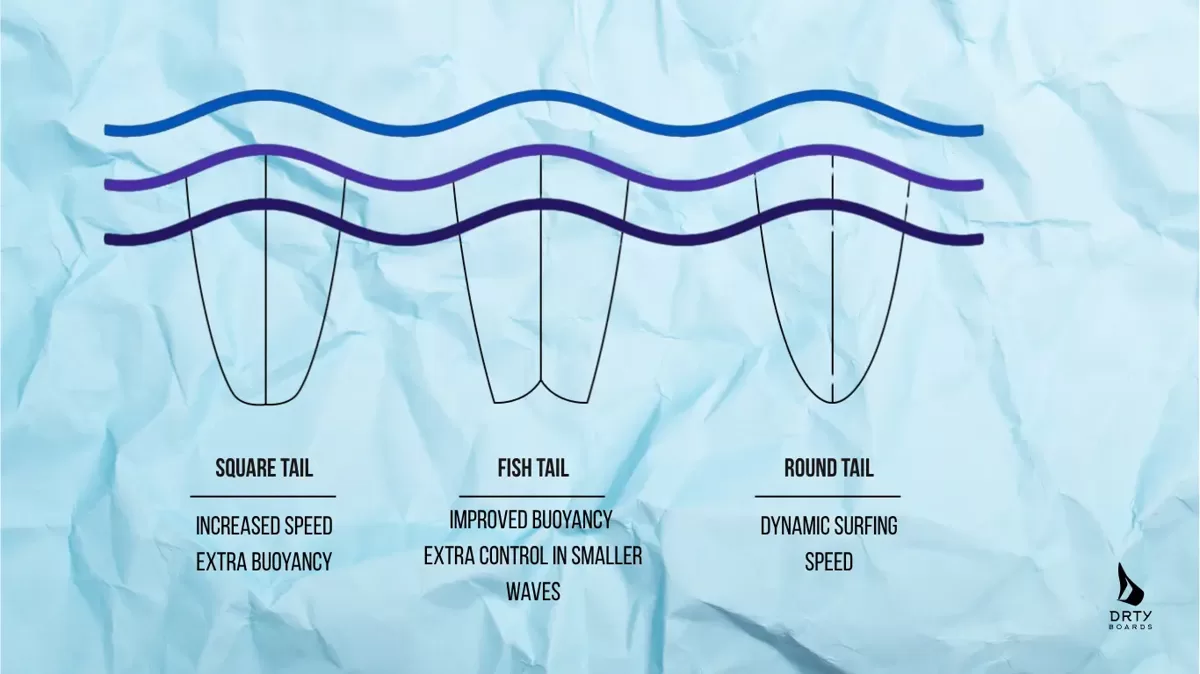
The tail, together with the fins, forms the main control zone of the board. Changes to the tail shape — such as width, outline, edge sharpness, and added elements like a Vee bottom — significantly affect how the board handles.
- Square tail: more speed and added float
- Fish tail: enhanced float and control in small waves
- Round tail: more fluid turns and smoother speed transitions
Life on the edge – rail types
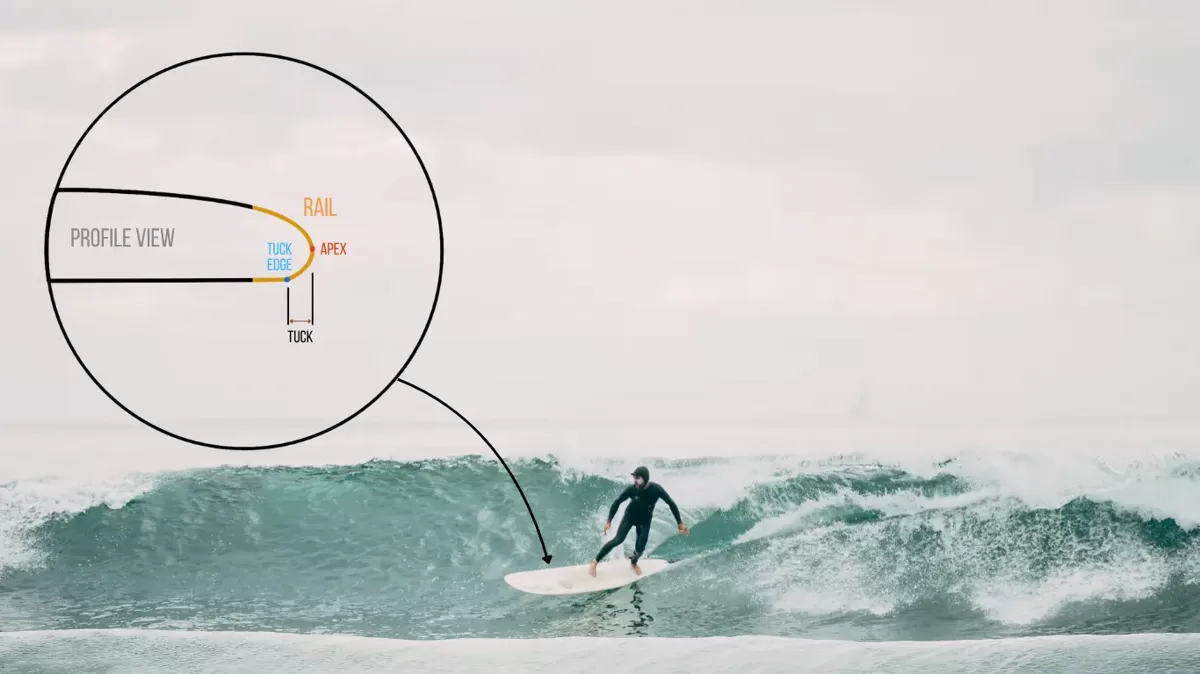
The rails (or edges of the board) affect overall performance. Their shape controls how water flows as the board glides and turns.
According to fluid dynamics:
- Rounded rails hold water molecules longer, increasing drag, which helps the board “stick” to the wave face for better control.
- Sharply defined rails release water more easily, reducing drag and giving the board more “looseness” for quicker turns.
Most boards feature rounded rails from the nose to around 40 cm before the tail; onwards from there the rails are sharper to help release water flow and enhance fin engagement during turns.
Most common rail types:
80/20 Rails (common on shortboards)
The apex the rail is offset downward by 80% from the top of the rail.
+ Pros:
- Less drag
- Faster rail-to-rail transitions
- Quicker turns
- Better control in steep, critical waves
- Cons:
- Lower buoyancy
- Less stability during turns
60/40 Rails (common on mid-length boards)
+ Pros:
- Balanced speed and stability
- More float than 80/20s
- Stability in whitewater
- Cons:
- Less control in steep waves
50/50 Rails (common on longboards)
+ Pros:
- More buoyancy = easier wave-catching
- Excellent stability
- Wider turning arcs
- Suitable for almost all conditions
- Ideal for beginners and traditional longboarders
Foil – the hidden ingredient behind speed and control
Foil refers to how the foam (volume and thickness) is distributed across the board.
There are two foil types:
- Nose-to-tail foil
- Deck-to-bottom foil (rail-to-rail)
A well-designed foil provides:
- Acceleration and drive
- Projection (via flex)*
- Planing** speed
- Manoeuvrability and tail control
*Projection: As the board flexes during a turn and returns to shape after the turn, it propels the surfer forward.
**Planing: The board rises onto the water’s surface with minimal resistance, increasing speed.
Bottom Contours – the board’s hydrodynamic engine

The shape of the surfboards underside affects water flow and overall hydrodynamic performance.
Concave (inward) shapes:
Single Concave (SC)
- Great speed in clean waves
- Can feel “sticky” in choppy surf
Double Concave (DC)
- Enhanced looseness and manoeuvrability
- Often combined with SC for extra lift
Flat Bottom (FB)
- Ideal for beginners and small waves
- Provides stability and easy glide
Channels
- Increase speed and drive by focusing water flow through the tail
Convex (outward) shapes:
Vee Bottom
- Eases rail-to-rail transitions
- Too much vee can reduce speed
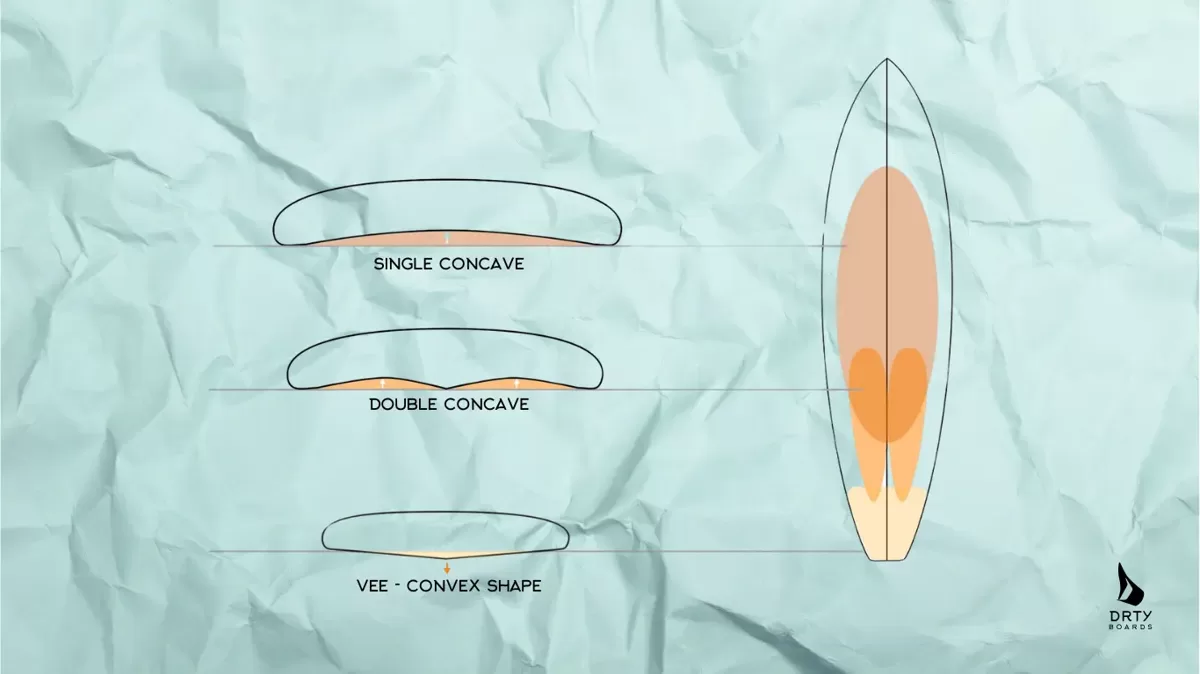
Which contours are best for Latvian waves?
- For beginners: Flat Bottom with minimal Single Concave
- For experienced surfers: Moderate SC into Double Concave, ending in Vee tail with sharp rear rails
Fin Setup – tuning your board’s personality
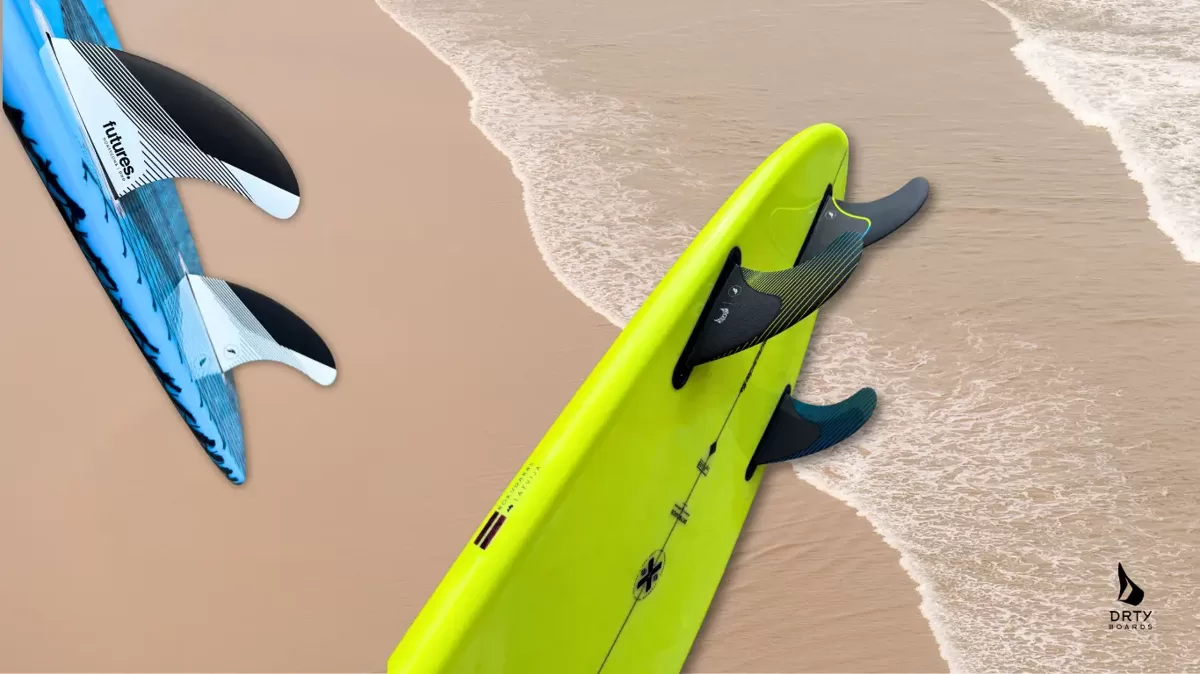
Different fin configurations affect how the board handles:
- Single Fin – classic feel and stable ride, perfect for longboards
- Twin Fin – faster and looser feel, good for smaller waves
- Thruster (3 fins) – most popular setup, balanced control and manoeuvrability
- Quad (4 fins) – increased speed and grip in steeper waves
- Five-Fin Setup – offers the option to switch between setups depending on conditions
In the near future, we will prepare a separate informative material about fins - their different types, performance, and how to choose the right ones for your board.
Materials and Construction
Boards are made from different materials, each affecting weight, durability, and performance:
- PU (Polyurethane) with fiberglass – the classic build, good flex and control
- Epoxy boards – lighter and more durable, but can feel stiffer
- Softboards (Softies) – foam boards ideal for beginners, safer and more forgiving
Final Thoughts – how to choose the right board?
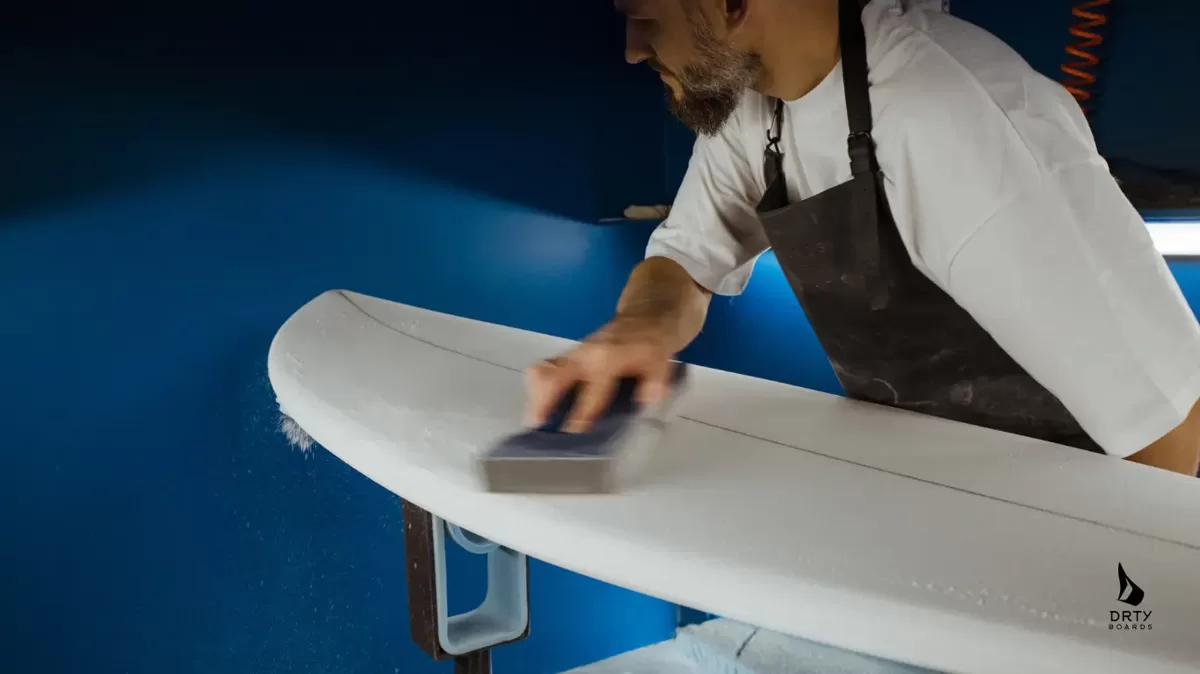
When choosing a surfboard, don’t just look at volume — also consider rocker, outline, stringer, fins, and board materials. If you’re a beginner, go for a stable, forgiving board with more volume and a fuller outline. If you’re more advanced, feel free to experiment with designs to match your surf style and conditions.
Most importantly — enjoy the ride and find a board that helps you progress and have fun on every wave!
If you want to find out more please get in touch with us!
